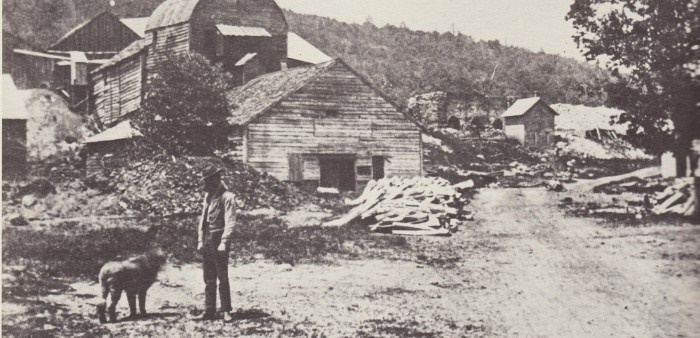Vermont is a beautiful state with a long history. The state is also home to numerous and interesting ghost towns and abandoned places. For an exciting fun day out with family, there are several historical ghost towns that you can visit in the state.
Here are just a few of the fascinating ghost towns in Vermont that you can visit:

1. Plymouth Five Corners, Vermont
Plymouth Five Corners began in 1787 as a small farming village known as Saltash. Most of the early residents were small-scale farmers growing crops and rearing cattle, chickens, and goats. The turning point of the village was in 1858 when a former Californian gold miner William Henderson discovered gold in the brooks flowing through the village. This sparked the famous (but short-lived) Vermont Gold Rush that caused a large influx of people creating a bustling town.
At its peak, Plymouth Five Corners was home to the Plymouth Gold Mining Company, a quartz mill, a sawmill, a gristmill, a school house, a boarding house, hotels, a post office, general stores, saloons and several other businesses.
When the source of the gold was not discovered and the small amount of placer gold was mined out of the creeks, most of the immigrants moved out of town leaving behind just a small village.
Today, not much remain of the Plymouth Five Corners town apart from old stone-lined cellar holes and footpaths used by gold panners in the area.
2. Tyson Furnace, Vermont
The town of Tyson Furnace was established in 1835 by Isaac Tyson, a mining expert who discovered rich iron ore deposits in the Black River Valley and set up mining operations in the area just a few miles from Plymouth. He built the Tyson Furnace town to house his employees. At its peak, the town had several furnaces, mills, a school house stores, a machine shop, boarding houses, hotels and several other businesses.
When Isaac Tyson retired in 1855 the mining operations were closed for several years before being reopened by a Boston Firm in the 1860s. This didn’t last long before the iron ore was for the most part exhausted. Most of the resident left town.
Today the area around the Tyson Furnace has some summer homes. Very little is left of the once-thriving mining town.
Read: Gold Prospecting Areas in Vermont
And: Metal Detecting for Relics in Old Mining Camps
3. Glastenbury, Vermont
The Glastenbury ghost town is located in the Bennington County. The town was chartered by Benning Wentworth (the Governor of New Hampshire), but due to the harsh terrain, not many people settled there. It was not until after the civil war that the first sawmill was built near the town changing the fortune of Glastenbury as more and more people settled there.
In the next few years, a railroad was built to connect the town, two additional sawmills were added in the 1870s, and a few dozens of Charcoal kilns for the Iron mining firms in the nearby Troy and Shaftsbury. These operations contributed to the growth of the town reaching several hundred people in population. At its peak, the town had a schoolhouse, a railroad station, a post office, general stores, a boarding house and several other businesses.
By early 1900s all the mature trees in the surrounding lands had been cleared and the mills and charcoal kilns had closed down. The town population slowly dwindled until 1937 when the town was unincorporated with a population of just eight people. Today there are still a few homes in the town with a population of fewer than ten people.
4. Lewiston, Vermont
Lewiston is located in Windsor County. The town was founded in 1765 around the major rail station in the area used by all the surrounding areas including Norwich, Hanover and New Hampshire areas. Lewiston was named after Dr. Joseph Lewis, one of the early inhabitants of the town.
The rail station was important to the supply of coal to the surrounding areas making Lewiston an important trading center in the region. At its peak, Lewiston had mills, general stores, the train station, boarding houses and several other businesses.
The discovery of oil and the exhaustion of lumber in the surrounding lands reduced the importance of the town to its neighbors. By 1930 Lewiston was slowly becoming another Vermont ghost town.
Today only the railroad station and a few structures owned by the Dartmouth University still remain at the site of this once prosperous town.
5. Somerset, Vermont
The Somerset ghost town is located in Windham County. The town was established in 1790 as a trading center for the surrounding farmlands. At its peak, it had several hundred residents, several businesses, and mills. With the lack of economic stimulant the town’s population dwindled until it was unincorporated in 1937. Today only a few abandoned homes and foundation of several other homes remain at the site of the town.
Also Read: 5 Old Ghost Towns in New Hampshire Worth Exploring
And: Metal Detecting Maine – Coins, Relics & Buried Treasure
6. Ricker Basin, Vermont
The Ricker Basin town was established in the mid-1800s as a farming town but quickly grew into a lumber town because of the presence of many mature timbers in the area. At its peak, the town had three sawmills, several hundred residents, a railroad station, general stores, a church, a school house and several other businesses.
The last sawmill operated by the Waterbury Last Block Co. closed shop in 1922 marking the end of the town. Flooding of 1927 and 1934 forced many people out town while the last remaining families moved away following the construction of the Waterbury Dam and Reservoir.
Today only a single run down house stand in the nearby Almeron Goodell Farm and a few foundations of other structures. Another of Vermont’s ghost towns with little left to show for a once thriving little community.







